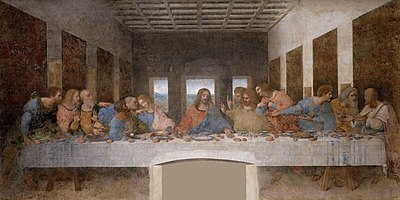
Back Abendmahl Jesu ALS العشاء الأخير Arabic ܚܫܡܝܬܐ ܐܚܪܝܬܐ ARC العشاء الاخير ARZ Sonuncu şam yeməyi Azerbaijani Huring Pamanggi BCL Тайная вячэра Byelorussian Тайната вечеря Bulgarian নিস্তারপর্বের ভোজ Bengali/Bangla Koan Diwezhañ Breton

The Last Supper is the final meal that, in the Gospel accounts, Jesus shared with his apostles in Jerusalem before his crucifixion.[2] The Last Supper is commemorated by Christians especially on Holy Thursday.[3] The Last Supper provides the scriptural basis for the Eucharist, also known as "Holy Communion" or "The Lord's Supper".[4]
The First Epistle to the Corinthians contains the earliest known mention of the Last Supper. The four canonical gospels state that the Last Supper took place in the week of Passover, days after Jesus's triumphal entry into Jerusalem, and before Jesus was crucified on Good Friday.[5][6] During the meal, Jesus predicts his betrayal by one of the apostles present, and foretells that before the next morning, Peter will thrice deny knowing him.[5][6]
The three Synoptic Gospels and the First Epistle to the Corinthians include the account of the institution of the Eucharist in which Jesus takes bread, breaks it and gives it to those present, saying "This is my body given to you".[5][6] The Gospel of John tells of Jesus washing the feet of the apostles,[7] giving the new commandment "to love one another as I have loved you",[8] and includes the detailed Farewell Discourse by Jesus, calling the apostles who follow his teachings "friends and not servants", as he prepares them for his departure.[9][10][11]
Some scholars have looked to the Last Supper as the source of early Christian Eucharistic traditions.[12][13][14][15][16][17] Others see the account of the Last Supper as derived from 1st-century eucharistic practice as described by Paul in the mid-50s.[13][18][19][20]
- ^ Zuffi 2003, pp. 254–259.
- ^ Cross & Livingstone 2005, p. 958, Last Supper.
- ^ Windsor & Hughes 1990, p. 64.
- ^ Hazen 2002, p. 34.
- ^ a b c Evans 2003, pp. 465–477.
- ^ a b c Fahlbusch 2005, pp. 52–56.
- ^ John 13:1–15
- ^ John 13:33–35
- ^ John 14–17
- ^ Cross & Livingstone 2005, p. 570, Eucharist.
- ^ Kruse 2004, p. 103.
- ^ Bromiley 1979, p. 164.
- ^ a b Wainwright & Tucker 2006.
- ^ Marshall 2006, p. 33.
- ^ Jeremias 1966, p. 51–62.
- ^ Meier 1991, pp. 302–309.
- ^ Pitre 2011.
- ^ Funk 1998, pp. 1–40, Intruduction.
- ^ Bultmann 1963.
- ^ Bultmann 1958.